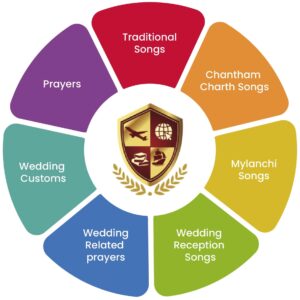
KNANAYA NUMEROLOGY
Numerology is a practice of looking into the significance of numbers. Biblical Numerology is the practice of correlating numbers with Biblical characters and events. Knanaya numerology is an interpretation of Knanaya history and practices based on the numbers involved. Knanaya customs have their roots in the Jewish, Biblical, and Indian cultures. Numerological interpretations are subjective and contextual. They help us memorize and reflect on our practices. The following are the numbers the Knanaites use and their Biblical and social application.
One: One stands for unity. There is only one God who exists as three Persons from eternity. He united the first couple, Adam and Eve, in marriage.
Several of the wedding ceremonies represent the unification of the bride and groom and their respective families, such as the clasping of hands by the paternal uncles during the betrothal, joint lighting of nilavilakku by the couple during the wedding liturgy, interchanging of rings, taking an oath while touching the bible, and partaking of milk and fruit from the same container.
Two: Two stands for unity in diversity. God gave ten commandments to Moses on two tablets. Jesus had a divine and human nature. God created humans as male and female. “A man shall leave his father and mother and be joined to his wife, and the two shall become one flesh? So they are no longer two, but one flesh” (Mt 19:5-6). The union of two is wholeness.
A wedding brings two people into a single family. A majority of the wedding rites illustrate the union of the bride and groom. The unification of the two families is shown through the wedding ceremonies such as the maternal uncles installing the poles for pandal, the paternal uncles joining hands during the betrothal, two uncles from each side acting as witnesses for the betrothal and marriage, the uncles assisting with washing hands for meals during the betrothal and wedding, and the mothers taking part in nellum neerum. The manarkolam was adorned with two fabrics: wool and a white linen. Eating on two plantain leaves, one on top of the other, was a tradition of the Knanaites to signify their nobility. During wedding-related dinners and other important occasions, two Knanaites would partake in a single plantain leaf, each consuming from its respective side. The Knanaites have two liturgical rites (Syro-Malabar and Syro-Malankara) and two branches (Catholic and Orthodox or Jacobite).
Three: Three is a symbol of completion or perfection. There is a correlation between the Holy Trinity, three temptations of Jesus, Peter’s denial of Jesus on three occasions, Jesus spending three days in the tomb, and Peter professing his love of Jesus three times.
In 345 AD, the Knanaites traveled on three ships to Kodungalloor. The Knanaya traditions involve repeating particular observances three times, such as requesting permission for rituals, Ichappad giving, nadavili three times, imposition of nellum neerum thrice, and kacha thazhukal by caressing three times. The thali comprises twenty-one buds, and its thread was composed of seven strands from manthrakodi folded three times, making twenty-one strands. Twenty-one results from multiplying seven to symbolize the seven sacraments and three to signify the Trinity. Knanaites consume three neyyappam along with one banana during the memorial service called manthra.
Four: The four signifies completeness, stability, and order. According to the Bible, there are four corners of the earth, four Gospels, four living creatures that surround God’s throne, and four winds.
Four priests were included in the Knanaya migration that took place in 345 AD. Thomas of Kinai received great recognition from King Cheraman Perumal after he brought back four casts who had left Kodungalloor for Sri Lanka. The kurandi and the canopy for the wedding have four supporting poles, the Knanaya wedding festivities concluded on the fourth day after the wedding, the Knanaites observe the 28th day after birth and the 28th day before the first death anniversary resulting from the multiplication of four and seven.
Five: According to the Bible, the number five stands for grace, mercy, abundance, and fulfillment of life. Examples: The Law of Moses has five books, Jesus multiplied five loaves and two fish to feed 5,000 people, five wise virgins, and the parable of servant who received five talents.
Before the prominent Synod of Diamper in 1599, the Knanaites were known as Ancharapallikkar because of their possession of churches in Udayamperoor, Kaduthuruthy, Kottayam, Chunkom (Thodupuzha), and Kallissery. They had partial ownership of some churches with the Northists, which earned them the label of “Anchara-pallikkaar” (Owners of five and a half churches). Panchavadyam, used for Knanaya wedding processions, was an orchestra of five instruments: timila, maddalam, ilathalam, idakka, and kombu.
Seven: Seven is often associated with perfection, completion, and holiness. Number seven is symbolic of the seven days of a week, the completion of the creation of the world in seven days, the seventh day being a day of worship and rest, and also the seven sacraments.
Knanaya immigrants in the year 345 were from seven clans. The older adults of Edessa urged the Knanaya migrants, at the time of their departure, to observe the Ten Commandments and the seven sacraments as outlined in the traditional songs. Thali has twenty-one buds, which is the product of seven times three. The thali cord is formed by obtaining seven strands from the manthrakodi. The church recognizes marriage as its seventh sacrament. Nellum neerum ritual involves the groom’s mother placing seven paddy grains submerged in water on a plate. The family of the pregnant woman takes care of her from the seventh month of her pregnancy.
Eight: This number represents new beginnings or renewal. After seven days, the eighth day marks the start of a new week. God instructed Abraham: “Throughout the ages, every male among you, when he is eight days old, shall be circumcised” (Gen 17:12). Israelites celebrated the Festival of Booths for eight days (Lev 23:34-36). God rescued only eight people, belonging to Noah’s family, from the great flood that re-created the universe.
The Knanaya women, as part of their tradition, observed a fast that lasted eight days, from September first to eighth, to prepare for the celebration of the Nativity of the Blessed Virgin Mary. This was to request the Blessed Virgin Mary and her mother Anna to provide a child with good health.
Seventeen: Combining the two perfect numbers ten and seven results in the number seventeen. The Bible associates the number ten with new beginnings and seven with spiritual victory and completion. The first month of the Jewish religious calendar begins on the seventeenth of Nisan.
Notable Biblical occurrences symbolizing a new beginning occurred on the seventeenth of Nisan. Examples: During the deluge, “In the seventh month, on the seventeenth day of the month, the ark came to rest on the mountains of Ararat” (Gen 8:4). Crossing of the Red Sea by Israel, the Jewish feast of first fruits, and the resurrection of Jesus occurred on the seventeenth day of the Nisan.
From the fourth century onwards, the Knanaites had power over seventeen castes. Hence, the barber asks at the Chatham Charthal, “I ask the nobles above seventeen casts; Shall I beautify the groom?”
Twenty-One: Seven times three is equal to twenty-one. Seven and three are numbers of perfection and holiness. As an example, the book of Revelation includes twenty-one judgments that are given on the earth, implying the conclusive judgement of God. Daniel abstained from food for twenty-one days in pursuit of a vision from God (Dan 10:2-3).
The Knanaya thali comprises twenty-one buds arranged like a cross on a banyan-shaped gold leaf. Gold, banyan leaf, cross, and the number twenty-one, which is a representation of the seven sacraments and the three persons of the Holy Trinity, signify the holiness of matrimony. Thali, comprising seven strands folded into three, resulting in twenty-one strands intertwined, conveys the sacredness, faithfulness, and unity of the couple. It was a tradition for the bride’s sister to bring appavum kaarikayum (two types of food known as aayani) to the church prior to the wedding. She gave twenty-one of these food items to the church as an offering. During the Church’s feasts, such as the feast of St. George, families made offerings of twenty-one pieces of rice bread (kallappam). The Knanaya women wore mundu or white dothi with 15 to 21 pleats, laid out in a fan-like manner, shielding the backside and back thigh.
Twenty-Eight: Twenty-eight is a product of two integers, seven and four. Although the exact length of a lunar month is 29.53 days, it is accepted that it is equivalent to four weeks. Twenty-eight is a symbol of perfection, new beginnings, faithfulness, and optimism. The tent cloth of the tabernacle was twenty-eight cubits long (Ex 26:2). Jehu reigned over Israel for 28 years (2 Kgs 10:36). The Gospel of Matthew and the book of Acts have twenty-eight chapters.
Parents perform a tradition of irupathettu kettu (knotting on the 28th day) on the 28th day of the child’s birth, which involves tying a thread and gold chain around the waist. The Knanaites honor the first anniversary of a person’s death according to the lunar year, which is 28 days before the solar year.
Forty-First: In the Bible, this number is linked to new beginnings or a fresh start. During Noah’s time, the floodwaters retracted after forty days of heavy rainfall. After spending forty years in the desert, the Israelites were eventually granted access to the Promised Land. After forty days without food, Jesus began his public ministry. Jesus ascended to heaven after 40 days of his stay on the earth.
As part of their mourning customs, the Knanaites celebrate the 41st day after the death of a person to signify the end of 40 days of grief and abstention from meat.
Seventy-Two: During Jesus’ public ministry, he had seventy-two disciples to carry out his missionary work.
The Knanaya immigrants in 345 AD comprised 72 families, chosen decisively for a missionary purpose.
Three Hundred Forty-Five: There is no explicit reference to the figure 345 in the Bible. However, the number 345 is an Angelic number, conveying a message from Angels that a significant life alteration is occurring. The numerical representation of three hundred and forty-five hints at opportunities, a person in need of mentorship and support, spiritual affluence, and good luck.
In the year 345, the Knanaya migration took place, which changed the lives of the Knanaites and the Christians who were living in Kodungalloor. This offered the Knanaites new opportunity and prosperity to the local leader and his people.
Four Hundred: According to the Bible, 400 is a period of testing followed by liberation. The Israelites lived in Egypt for 400 years (Gen 15:13; Ex 12:40; Acts 7:6). God then led them to the promised land by crossing the Red Sea.
Four hundred Knanaites arrived in Kodungalloor in the year 345 AD.
Half: This signifies an absence of fulfillment and a desire for completeness. St. Thomas established seven and a half churches. That means he founded seven churches and various small Christian communities.
Knanaites were known as Anchara-pallikkaar (Owners of five and a half churches) where the half represented the churches the Knanaites shared with other Syro-Malabar parishes. Knanaites had seventy-two and a half privileges where the half privilege was eating meals in the folded plantain leaves.
PREPARED BY FR. ABRAHAM MUTHOLATH

The Knanayology Foundation (Knanaya Global Foundation NFP), a non-profit organization registered in IL, USA, hosts Knanayology and undertakes other projects on Knanaya Community .







